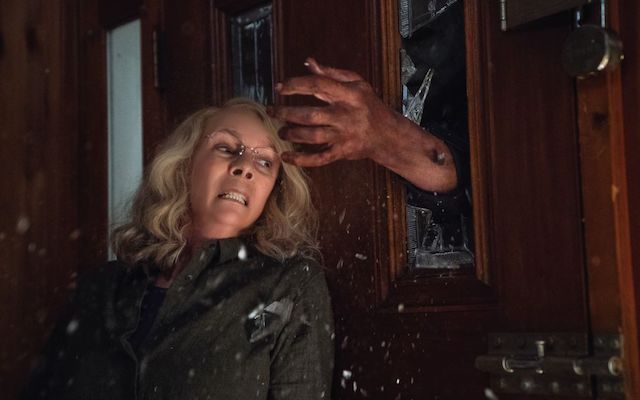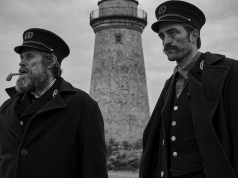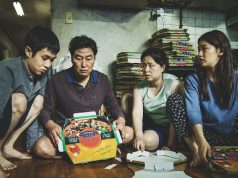
The 2018 “Halloween” is a direct sequel to the 1978 “Halloween,” and it exists in a timeline where there were never any other sequels, not even the one that erased the other ones. Michael Myers killed four people that night (that’s not counting his sister Judith 15 years earlier) and was evidently captured without further incident after vanishing at the end of “Halloween” (1978). He has spent the intervening 40 years locked up, never speaking — not one word — to anyone, ever, not to Dr. Loomis (RIP Donald Pleasence) and not to Dr. Sartain (Haluk Bilginer), the late Dr. Loomis’s extremely Dr. Loomis-like replacement.
It’s possible Michael Myers doesn’t even know the name of the random babysitter who survived her encounter with him, Laurie Strode (Jamie Lee Curtis). She wasn’t his long-lost sister — that was an urban legend that sprang up later. She was just some normal girl whose life was ruined by the trauma she suffered that night. She became famous in Haddonfield for being a victim, a damaged item, the subject of pity and rumors. She lived in constant, obsessive fear of Michael’s return, driving away husbands as she raised her daughter, Karen (Judy Greer), to be a paranoid survivalist. Now Laurie has a granddaughter, Allyson (Andi Matichak), who’s the age she was in 1978, whom she hardly sees because Laurie lives in a fortified bunker behind a barrage of locks and rarely goes outside.
But Michael doesn’t know any of that. Laurie’s fear that he will return for her is irrational, like being afraid of getting struck by lightning a second time. That she has misspent her life stockpiling ammunition in a secret basement, preparing for a day that reason dictates will never come, all while ruining her personal relationships, is tragic, not heroic, a heartbreaking example of how the effects of violence can ripple across generations.
So it makes no sense when Michael Myers does escape and come after Laurie Strode. He has no reason to do it and no way of knowing where she is. By erasing the Michael-Laurie sibling connection, director David Gordon Green and co-writers Danny McBride and Jeff Fradley undermine the entire premise of the movie. Moreover, the story now inadvertently carries a dismal message: “Hey, trauma survivors, you know how you’re constantly terrified it will happen again? It very well might! Stay vigilant!”
Which is strange and unfortunate, since the film is otherwise empowering and satisfying as the resolution to Laurie’s story, which stands in for the stories of all women who seek victory over their personal Michael Myerses. Early in the movie, a pair of English journalists (Rhian Rees and Jefferson Hall), doing a story about Michael, suggest to Laurie that perhaps she should sit down and talk to him, that maybe we shouldn’t totally discount his point of view just because he’s a murderer. Laurie’s response is to rise, walk to the door, open it, and say, “Time’s up.” She just means that this interview is over, but the current connotation of that phrase is unavoidable. Spend one more minute letting bad men justify themselves? NOPE. Of course, this message is bound to be undermined, too, when “Halloween” (2018) itself spawns sequels in which Michael continues to kill and get away with it. The slasher-movie equivalent of white male privilege, after all, is suffering death for your crimes at the end of the movie but coming back in the next one anyway.
Subtext aside, it’s a passable “Halloween” film, certainly the most beautifully photographed one (kudos to arthouse cinematographer Michael Simmonds), and fortified with a body count that is high but not ridiculous. None of the “fan service” moments are egregious, and at least one is a terrific, wholly justified callback. The mini-dramas with doomed characters preceding their demise show Green’s usual knack for quiet intimacy, and a sequence with a babysitter (Virginia Gardner) and her sassy young charge (Jibrail Nantambu) provides welcome comic relief.
The movie is only mildly scary, though, and while it pretends the sequels don’t exist, it also relies on our fondness for them when it delivers, for example, the requisite sequence where a horny pair of teenagers get offed. Indeed, the very idea of Michael Myers being such a familiar local legend that everyone just refers to him as “Michael” only makes sense if he’s been a recurring presence, not one who went on a one-time killing spree 40 years ago and spent the rest of his life behind bars. (How many serial killers are popularly known only by their first names?) But the well-orchestrated finale is immensely satisfying, cashing in on the tension and symbolism built up in this particular film and over the last four decades. The whole thing might be better as a symbol than as a “Halloween” movie, but it’s not a bad “Halloween” movie.
B- (1 hr., 45 min.; )





